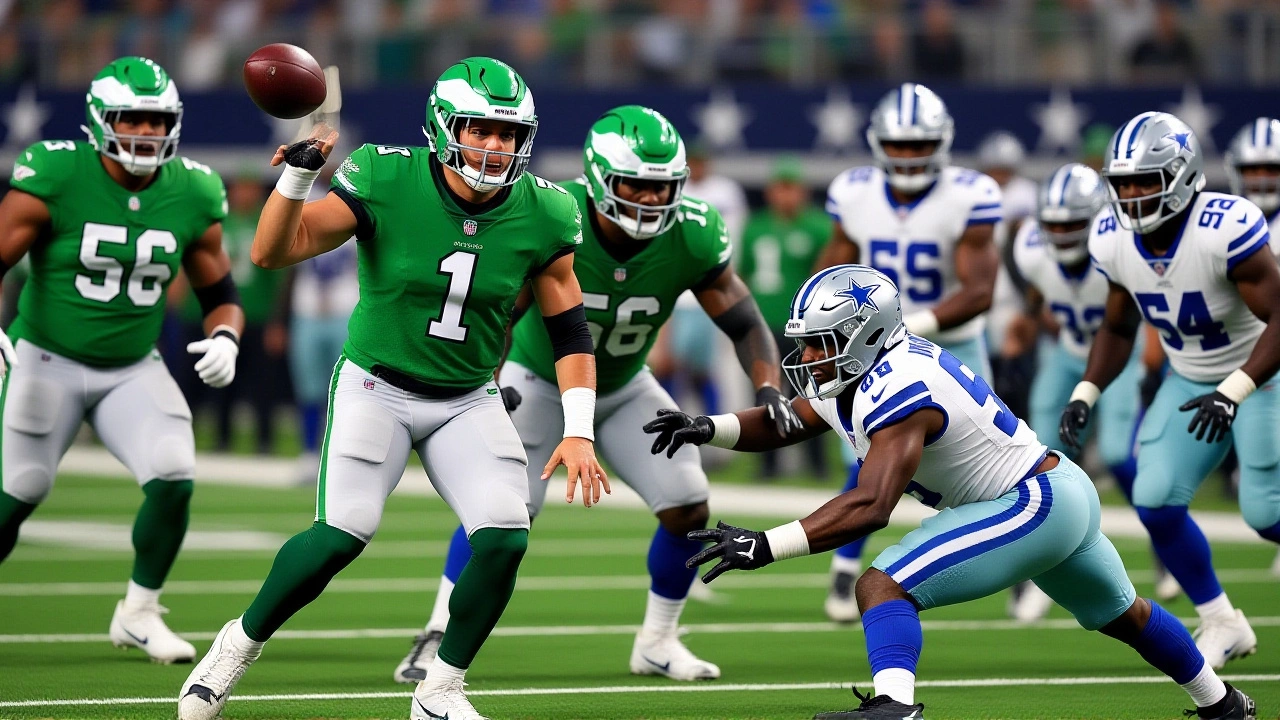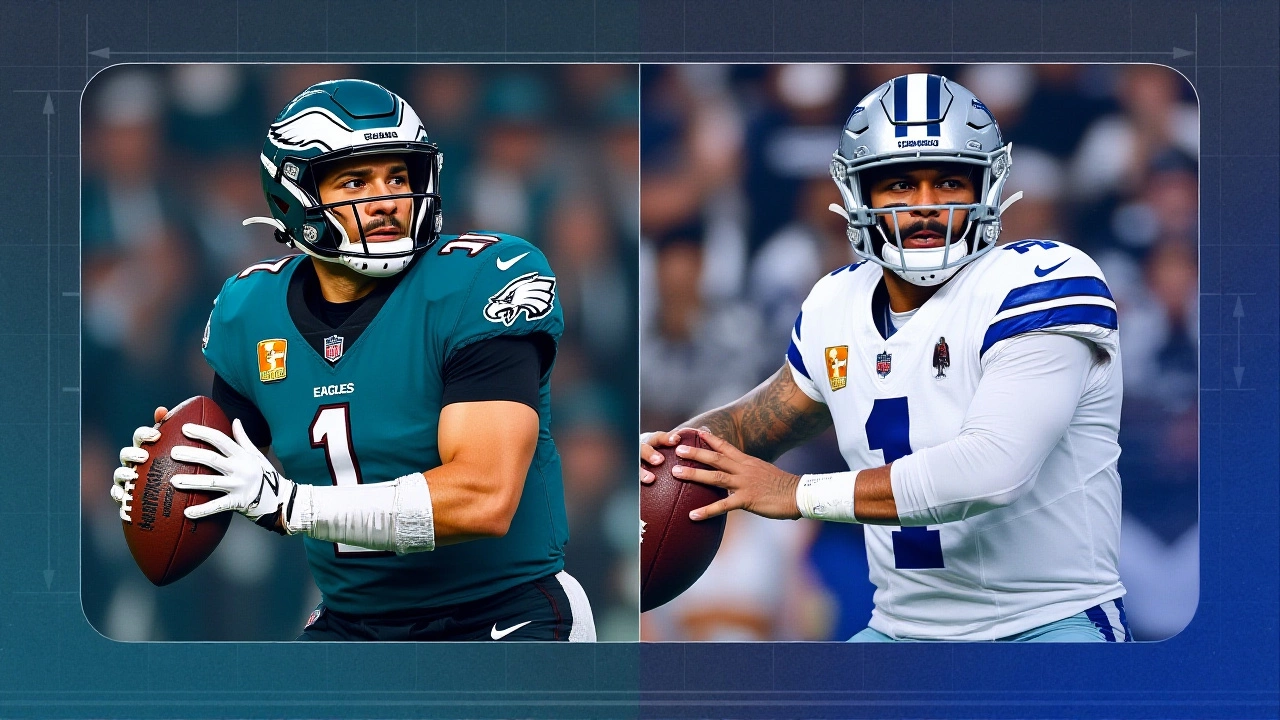The Dallas Cowboys lost 27-20 to the Philadelphia Eagles on November 23, 2025, in a game that turned on one devastating play: A.J. Brown turned a short slant into an 110-yard touchdown, slicing through Dallas’ secondary like a knife. It wasn’t just a big play—it was a statement. The Cowboys, reeling from a coaching purge and a patchwork roster, now sit at 6-5, clinging to playoff hopes as the season enters its final stretch. The loss wasn’t just about one receiver’s brilliance. It was the culmination of months of upheaval that began when Dallas Cowboys fired longtime head coach Mike McCarthy on January 13, 2025, after eight seasons. The team didn’t just change coaches. They rebuilt the entire offensive and defensive architecture from the ground up.
From McCarthy to Eberflus: A Coaching Revolution
When Mike McCarthy was let go, fans expected a tweak. What they got was a full reset. Within weeks, the front office hired Matt Eberflus as defensive coordinator on January 28, 2025—a move that surprised many, given Eberflus’ reputation as a former head coach with the Chicago Bears. Then came Klayton Adams on February 1, 2025, as offensive coordinator, a relatively unknown name from the college ranks. And on February 7, Conor Riley was brought in to overhaul the offensive line. The message was clear: no one was safe. No legacy was sacred. The Cowboys were betting everything on a new identity.
Roster Rebuild: Veterans, Depth, and the Long Game
Behind the scenes, the front office—led by owner Jerry Jones—was quietly reshaping the roster. On March 4, 2025, they locked in key contributors: Osa Odighizuwa got a four-year extension, while Dakoda Shepley, C.J. Goodwin, and Brock Hoffman all signed one-year deals. It wasn’t flashy, but it was smart. These were the guys who made the machine run quietly—special teams, depth linemen, rotational defenders. Then came the April moves: acquiring Joe Milton III from the New England Patriots for a fifth-round pick, and signing guard Hakeem Adeniji to shore up the interior line. The message? Protect the quarterback. Build depth. Don’t gamble on stars.
By November, the adjustments were in motion. On November 12, Marcellus Johnson, a 6’7” offensive tackle with starting experience, was signed off the street. Two days later, Malik Hooker was activated from injured reserve—a crucial boost for a secondary that had been shredded by injuries all season. But the timing was brutal. Hooker returned just as the team faced Philadelphia Eagles, whose offense, led by Jalen Hurts, had gone 12 straight games without an interception when favored by fewer than seven points. Hurts didn’t throw one that day either. He didn’t need to. A.J. Brown did the work.
The A.J. Brown Effect: One Play, One Night
It wasn’t just that Brown caught 110 yards. It was how he did it. On a second-and-8 in the third quarter, Hurts faked a handoff, rolled right, and fired a bullet to Brown near the sideline. Malik Hooker, playing his first snap in six weeks, was caught flat-footed. Brown turned, broke a tackle from rookie cornerback Tre’Von Morgan, and sprinted the rest of the way. The crowd at AT&T Stadium went silent. The Cowboys’ defense, which had held firm for three quarters, suddenly looked lost. That play wasn’t just a highlight—it was a symptom. The new system, still finding its rhythm, couldn’t handle elite speed with inconsistent communication. And Brown? He’s the kind of player that exposes that.

Who’s Exceeding Expectations? The Unnamed Heroes
Despite the loss, the Cowboys’ official site published a piece titled “High 5: Cowboys Exceeding Expectations in 2025.” The article didn’t name names. But sources say it included Joe Milton III, who’s now the clear backup QB and has shown poise in relief roles. Also on the list: Marcellus Johnson, who started at right tackle in Week 11 after injuries to starter Tyron Smith. Then there’s Will Grier, the former backup who’s now the emergency QB and has been quietly sharp in practice. And Malik Davis, the running back signed in January, who’s now the team’s third-down specialist with 14 receptions in his last five games. These aren’t stars. But they’re the reason the Cowboys are still alive.
What’s Next? The Final Five
The Cowboys have five games left. Three are against division rivals: the Eagles (again), Washington, and the New York Giants. They need to win at least four to have a shot at the playoffs. The defense has to fix its coverage issues—especially on short routes. The offensive line must protect the QB better, especially with Tyler Smith still working through a shoulder strain. And they need Malik Hooker to stay healthy. The coaching staff says they’re “building for the long term.” But with the season on the line, long term feels like a luxury.

Behind the Scenes: The Frisco Machine
While fans watch the games, the real work happens at The Star in Frisco, Texas. The Cowboys’ sprawling headquarters is a 91-acre complex where analytics, film study, and medical rehab operate 24/7. This season, the front office has leaned harder than ever on data—tracking player fatigue, route-running efficiency, even how often defenders blink before a snap. They’re not just reacting anymore. They’re predicting. The problem? Football is still played by humans. And humans make mistakes. Even when you have the best tech in the league.
Frequently Asked Questions
How has the Cowboys’ defense changed since Mike McCarthy’s departure?
Under Matt Eberflus, the Cowboys shifted from a zone-heavy scheme to a more aggressive, blitz-heavy system with increased man coverage. The result? More sacks (up from 28 in 2024 to 41 through Week 12) but also more big plays allowed—like A.J. Brown’s 110-yard TD. The transition has been messy, especially with injuries to safeties like Malik Hooker.
Why did Dallas trade for Joe Milton III?
With Dak Prescott still recovering from a 2024 ACL tear and Cooper Rush inconsistent, the Cowboys needed a reliable backup. Milton, a former Michigan State starter with a strong arm and poise, was available for a late-round pick. He’s now the primary backup and has started two games when Prescott was sidelined, showing enough promise to be considered a future starter.
What’s the significance of Malik Hooker’s return from IR?
Hooker’s return gave Dallas a veteran presence at safety after a season plagued by injuries. He had 3 interceptions in 2024 and is one of the few players on the roster who can cover tight ends in man coverage. His absence in Week 12 contributed to A.J. Brown’s big play, underscoring how critical his health is to the defense’s stability.
Why didn’t the Cowboys re-sign Mike McCarthy?
Despite leading the team to two playoff appearances, McCarthy’s offense became predictable, especially in critical situations. The team ranked 25th in red-zone efficiency in 2024, and his reluctance to adapt to modern passing schemes frustrated owner Jerry Jones. The decision was less about performance and more about philosophy—Jones wanted a more aggressive, dynamic approach.
How do the Eagles compare to the Cowboys in 2025?
Philadelphia has been more consistent, thanks to Jalen Hurts’ elite decision-making and a stable coaching staff. While Dallas shuffled coordinators, Philadelphia kept Brian Johnson as OC and Sean McDermott as DC. The Eagles are 8-3, with a top-5 offense and a defense that ranks in the top 10 in yards allowed. Dallas, by contrast, is still figuring out its identity.
What’s the outlook for the Cowboys’ 2026 offseason?
If the Cowboys miss the playoffs, expect major changes: a new offensive coordinator, a potential draft pick for a franchise QB, and possible moves to upgrade the offensive line. Jerry Jones has signaled he’s willing to spend, but only if the new regime proves it can execute. The 2026 draft class is loaded with quarterbacks—so the franchise may finally take the plunge.
